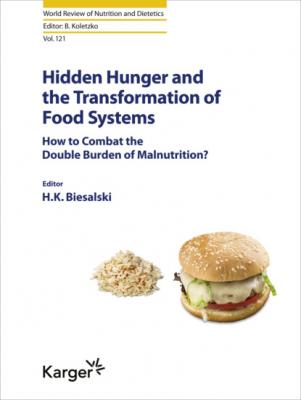Hidden Hunger and the Transformation of Food Systems. Группа авторов
Читать онлайн.| Название | Hidden Hunger and the Transformation of Food Systems |
|---|---|
| Автор произведения | Группа авторов |
| Жанр | Спорт, фитнес |
| Серия | World Review of Nutrition and Dietetics |
| Издательство | Спорт, фитнес |
| Год выпуска | 0 |
| isbn | 9783318066982 |
From these circumstances, a new kind of hunger has appeared, called “hidden hunger” (Table 1). Hidden hunger is the lack of vitamins and minerals that occurs when consumed food lacks the essential micronutrients necessary for growth and development [5]. Globally, almost 2 billion people, mostly in low- and middle-income countries (LMICs), suffer from “hidden hunger.” Together, with existing undernutrition (stunting and wasting) and overnutrition (overweight and obesity), this “double burden of malnutrition” indicates a growing, dire global food crisis [9]. The double burden of malnutrition, driven by poor diet quality, especially affects children and adolescents and undermines their capacity to grow, develop, and learn to their full potential. Some examples of hidden hunger include vitamin A deficiency, which is the main cause of irreversible blindness in children, and iodine deficiency, which can harm a child’s ability to learn [5]. Iron-deficiency anemia in children and adolescents is associated with fatigue and may prevent children from paying attention in class. Unfortunately, the effects of hidden hunger are often invisible or manifest too late for proper recovery, hence the term “hidden” [5].
Table 1. Malnutrition definitions
Tackling and preventing hidden hunger through an integrated, rights-based food systems approach is crucial to adequately address this issue and to ensure optimal growth and development of school-aged children and adolescents today and in future generations [10]. Using the Innocenti Framework on Food Systems for Children and Adolescents (2019) as guidance (Fig. 1) [11], there are various cost-effective, delivery intervention platforms through the food system, including agricultural production and food processing, promotion of enabling food environments, and behavioral change. Importantly, synergistic actions with other major systems, including social protection, water and sanitation, health, and educational systems are necessary for long-term impacts in nutrition and population health. This includes the use of supplementation and disease-control measures to mitigate hidden hunger, as recommended by the World Health Organization (WHO).
Interventions to Address Hidden Hunger through the Food System
Agriculture and Biofortification
Agriculture is the foundation to all food systems and is a critical aspect in the provision of healthy, sustainable, safe diets for children and their families globally. Although modern large-scale, industrialized, agricultural systems have exponentially increased in productivity (agricultural intensification), there are several notable implications to continuing with business-as-usual, including erosion of biodiversity, climate change, water depletion, land degradation, and increased pollution [12, 13]. Importantly, designing biologically integrated agroecosystems that rely on internal cycling of nutrients and energy and improved soil functioning will maintain an economically viable, but also sustainable, adaptable, and resilient production system. This can be achieved through structural shifts within the system and mobilizing efforts towards crop diversification [12].
Fig. 1. The Innocenti Framework on Food Systems for Children and Adolescents.
Currently, two-thirds of the world’s caloric intake is attributed to three staple foods – rice, wheat, and maize [7]. However, in order to address hidden hunger, dietary diversity is key. Conservation of genetic and varietal diversity of crops allows for improved system stability and, intuitively, availability of macro- and micronutrients from diverse foods. By extension, this strategy has the potential for greater impact amongst smallholder farmers [12]. Today, 4 out of 5 of the world’s rural poor subsist from agriculture as smallholder farmers. Through increasing crop species richness, smallholders not only contribute to the sale of diverse crops, but also their consumption in the household. Empirical evidence from eight developing countries illustrates a positive correlation between the number of crops cultivated, household income from crops, and the two indicators for dietary diversity, after adjustment for household characteristics [14].
Despite this, there are important considerations of such agrobiodiversity strategy on hidden hunger impact, as addressing diversity on the farm does not infer diversity in diets [15]. Determinants, such as market access (proximity, type, price-to-wage ratios, seasonality, consumer preferences), land size (including intra-familial subdivision), and women’s involvement in smallholder farming, drive great heterogeneity in nutritional outcomes, and should be considered to ensure fair access to dietary diversity and better nutrition for everyone. As women have substantial involvement in farming in developing countries, households headed by women, with direct influence on income and resource allocation decision making, show greater positive influences on household and child dietary diversity, as compared to households headed by men [12, 15]. Receiving greater dietary diversity and better nutrition in the home may better mitigate the negative influences, and subsequent poor dietary intake, children and adolescents may face in other environments.
However, it is important to note that despite agrobiodiversity, the reliance on calorically dense staple foods with inherently low micronutrient content is problematic for resource-poor populations. Therefore, biofortification, the process of selectively breeding staple food crops with higher micronutrient content crops, either through conventional plant breeding, genetic manipulation (transgenic), or agronomic interventions (nutrient-rich fertilizer application), has been positioned
